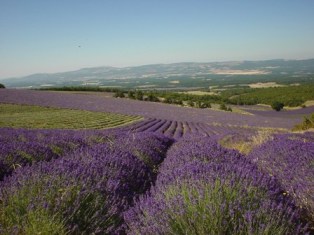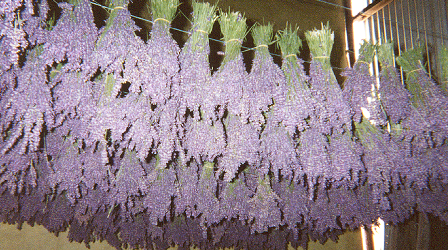Have you purchased a small farm, or are you interested in lavender and thinking of starting a lavender farm? Many people do, some as a paying hobby and others that go on to make a successful business from it.
Background to lavender farming
Compared to most other agricultural crops lavender can provide an excellent return from a small area. There is however a limit to the area of lavender that can be successfully grown at any one point in time. For most producers this area is around five hectares. It is possible to grow a larger area, however a larger farm is required with a much greater capital investment. A large commercial lavender farm in France.
 |
Keys to growing lavender successfully
Before setting up a lavender farm a number of preliminary decisions need to be made. These decisions need to be based on what you want to do on a daily basis and how much money you would like to earn? The best lavender returns come from agri-tourism, this is where the lavender farm becomes an attraction for tourists. This business method requires the owner to have the right personality to deal with the public.
If you are a person who likes to keep to themselves or your property is not on a main road or near a tourist precinct then agri-tourism will be difficult to achieve.If the idea of growing lavender is still of interest then you are best to develop a sales channel through a network of tourism outlets, not necessarily lavender.
Site Selection and set up In selecting your site there are a number of important considerations. First, lavender must have plenty of direct sunlight (at least 5 hours per day), very good drainage and lots of air movement.
Secondly, although lavender survives under dry weather conditions a commercial crop responds well to irrigation and regular autumn watering. Fertiliser is not critical however lavender does require high levels of Calcium and a pH of 6.8 to 7.3. Finally, depending on what type of business you intend to run there may be a need for shedding, retail area, car and bus parking and gardens.
Setting up a lavender farm does not necessarily need to be a large capital expense. Purchasing lavender plants is the most expensive part of the set up. Approximately 10,000 plants are required per hectare, with lavender plants ranging in price from $1.20 to $3.00 each, depending on the variety. The next largest set up cost is the purchase and installation of irrigation equipment and the preparation of the soil. High capital costs are required when distillation equipment or more advanced tourism is desired. The cost of these items ranges from a few thousand dollars for a small still and packaging area to several hundred thousand dollars for a large still, retail area and cafe.
Lavender products
There are two main products produced from lavender other than the fresh flowers. These are the stripped florets and the oil. The stripped flowers are used in cooking, pot-pourri and cosmetics. To produce stripped lavender you need a small to medium sized shed for a drying and stripping machine. This equipment needs to be home made as currently there are not any commercial units available. Drying Lavandula angustifolia after harvest. The second product is the lavender oil. This is used in perfumery, cosmetics, culinary and cleaning agents. Lavender oil is produced by steam distillation; therefore a steam still is required to produce the oil. A small still will cost around one thousand dollars with a medium sized one costing upwards of ten thousand dollars. A small to medium sized shed will be needed to store the still, a clean dry area for bottling and a cool dark shed for storage.
 |
Lavender species
There are over thirty species of lavender of which only two species are used for commercial oil production; a few other species are used for fresh and dried flowers. When producing lavender oil it is critical to use the correct varieties. The two main species are Lavandula x intermedia (L. angustifolia x L. latifolia) [Lavandin] and Lavandula angustifolia [Lavender]. Lavandin produces oil with a medium level of Camphor; this oil is primarily used to add fragrance to cleaners. Oil produced from Lavender plants is used for perfumery, cosmetics and culinary, it is low in camphor with a sweet old fashioned fragrance. Bath Lavender and Lavandin oil can be produced from a number of commercially available varieties.
Some varieties are unsuitable for commercial production and others have very low yields and are not economical. It can be difficult to differentiate some of these attributes by their external morphology. Hence, it is important that plants are purchased from a recognised propagator who can give assurance on the source of their stock plants. Lavender plants for oil production should not be grown from seed.
Where to from here?
After reading this information and if lavender farming is still for you, it is best to do some further reading. This includes:
- Lavender the Growers Guide by Virginia McNaughton
- The Genus Lavandula by Tim Upson and Susyn Andrews
Larkam Nurseries also produces a booklet for $100 that gives the basics to prospective lavender growers. The $100 is then rebated off lavender plant purchases. Once this has been completed, visit a number of lavender farms and if you are planning to farm lavender on a commercial scale engage a l lavender professional who has experience in the industry.
Acknowledgement
This article is courtesy of Clive Larkman from Larkman Nurseries. Clive is a botanist, qualified horticultural consultant with significant management experience in several industries including lavender.



